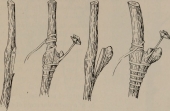









Sustainable Plantations and Agroforestry in Costa Rica









Sustainable Plantations and Agroforestry in Costa Rica








Pastured pork and beef on Vashon Island, WA.




Fred Morgan wrote:This is a bit of a myth, regarding taproots. (just so you know, I am a bit of an expert in growing trees) Just because you destroy the tap root, doesn't mean it will never come back. Think of it this way, if you cut out the central leader (i.e. main trunk) of a tree, does that mean you will never have to prune for that again? Yeah, you wish. Trees are incredibly resilient, and will attempt to grow back, no matter what you do. We plant trees all the time from nurseries, and yes, it would be nice if they still had their tap roots, but after a few years, the tree does have one. The roots will seek nutrients, never fear. And as far as stability, there is nothing harder to keep up, than a tree alone in a field. In the middle of other trees, they are protected from winds, etc.
homesteadpaul




The ultimate goal of farming is not the growing of crops, but the cultivation and perfection of human beings. - Masanobu Fukuoka








"Solve world hunger . . . tell no one." The, the, the, . . . THE GRINCH!









homesteadpaul Hatfield wrote:
Fred Morgan wrote:This is a bit of a myth, regarding taproots. (just so you know, I am a bit of an expert in growing trees) Just because you destroy the tap root, doesn't mean it will never come back. Think of it this way, if you cut out the central leader (i.e. main trunk) of a tree, does that mean you will never have to prune for that again? Yeah, you wish. Trees are incredibly resilient, and will attempt to grow back, no matter what you do. We plant trees all the time from nurseries, and yes, it would be nice if they still had their tap roots, but after a few years, the tree does have one. The roots will seek nutrients, never fear. And as far as stability, there is nothing harder to keep up, than a tree alone in a field. In the middle of other trees, they are protected from winds, etc.
Actually, there are many types of tree that if you cut the leader, you end up with more of a bush: many smaller stems instead of a single leader. On some taprooted trees, the initial meristem (the very tip of the first root to sprout from the seed) is the only part of the plant that is ever attracted to "down." If it is lost, some trees, like white oak, will be stunted and others will develop more of a "heart-root" pattern, and not a true taproot. Just like many trees never regain a central leader after it has been cut. At least with the leader, if you want one you can prune off all but one and recover a leader.
I made the mistake a few years ago of thinning a grove of pine trees too much. That let the wind in and a number of them blew over. I knew that might happen and I thought I had left enough, but evidently did not. Trees that start in the middle of a field and never have protection may grow twisted, but rarely blow over. They grow enough roots to keep anchored.

Sustainable Plantations and Agroforestry in Costa Rica





Sustainable Plantations and Agroforestry in Costa Rica








Brenda
Bloom where you are planted.
http://restfultrailsfoodforestgarden.blogspot.com/




eric firpo wrote:
A few questions. I saved lots of seeds this year to plant an orchard, but are there any stone fruit trees that breed true from seed?
Also, I've heard Paul (and read Holzer and Fukuoka) say that pruning is unnecessary and it's preferable to just let nature take its course with tree growth. But it seems to me that grafting (if the tree will not breed true) is a form of pruning. So, when do you graft when planting from seed? Year one or two or later?
And will the tree need to be pruned after grafting, since the wisdom appears to be that once pruned, a fruit tree must be pruned for life?
Thanks!
 1
1




The ultimate goal of farming is not the growing of crops, but the cultivation and perfection of human beings. - Masanobu Fukuoka




Jordan Lowery wrote:Allowing the rootstock branches to grow will result in a tree that is rootstock not your cultivar. Rootstock = stronger, that's why we graft onto it.




















 2
2








 your 1ft seedling is at a disadvantage
your 1ft seedling is at a disadvantagewe have to forest our farms and farm our forests

|
There is no "i" in denial. Tiny ad:
Freaky Cheap Heat - 2 hour movie - HD streaming
https://permies.com/wiki/238453/Freaky-Cheap-Heat-hour-movie
|


